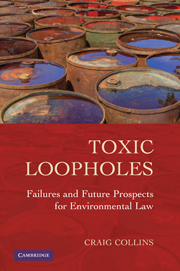Book contents
- Frontmatter
- Contents
- Dedication
- Introduction: Crime Without Punishment
- 1 The EPA – Policing or Protecting Polluters?
- 2 The Clean Air Act – Gasping for Breath
- 3 The Clean Water Act – Up Sh*t Creek
- 4 Superfund and RCRA – Toxic Trash
- 5 TSCA – The Toothless Tiger
- 6 The Endangered Species Act – Noah's Ark or Titanic?
- 7 Planetary Problems – Cooperation or Collapse?
- Conclusion: A Glimmer of Hope
- Bibliography
- Index
2 - The Clean Air Act – Gasping for Breath
Published online by Cambridge University Press: 05 June 2012
- Frontmatter
- Contents
- Dedication
- Introduction: Crime Without Punishment
- 1 The EPA – Policing or Protecting Polluters?
- 2 The Clean Air Act – Gasping for Breath
- 3 The Clean Water Act – Up Sh*t Creek
- 4 Superfund and RCRA – Toxic Trash
- 5 TSCA – The Toothless Tiger
- 6 The Endangered Species Act – Noah's Ark or Titanic?
- 7 Planetary Problems – Cooperation or Collapse?
- Conclusion: A Glimmer of Hope
- Bibliography
- Index
Summary
To be deadly, the air you breathe doesn't have to be brown and smelly or sting your eyes. Sure, some airborne contaminants, such as the brownish-gray smog caused by ground-level ozone, can be seen and smelled. But others, such as carbon monoxide, radon and BPA (Bisphenol-A), fly under the radar of our senses. In fact, the most noxious types of airborne toxins are so virulent they can cause illness, disability, cancer, reproductive problems and even death at levels difficult to detect by even the most advanced technologies.
Air pollution was the first type chosen by Congress for federal regulation. Airborne contaminants are especially dangerous because the lungs provide them with direct access to our bloodstream. The average adult breathes about 3,400 gallons of air every day. At this great volume, even unimaginably minute concentrations of some airborne toxins can do grave damage to our bodies.
Most of us underrate the menace of airborne pollutants. The number one killer in America is heart disease; lung cancer is the number one cancer killer and asthma is the number one chronic disease in children. These diseases have a frightening commonality – air pollution makes all of them worse. In the United States, traffic fatalities total just over 40,000 per year, while air pollution claims at least 70,000 lives annually – as many as breast and prostate cancer combined.
- Type
- Chapter
- Information
- Toxic LoopholesFailures and Future Prospects for Environmental Law, pp. 35 - 53Publisher: Cambridge University PressPrint publication year: 2010

